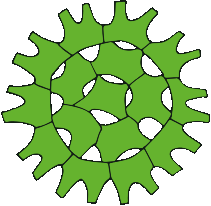Took a ride to Lövö today. Went to the water near the old ferry point and took a sample. Back at the office I saw some fine, common spring algae of the Baltic Sea, like this Nitzschia frigida : Nice to see some fresh algae again, after all those lugol samples.
Plankton
Baltic Sea phytoplankton taxa
Wuuh, what did I find now!!? The famous Guy Hällfors Baltic Sea Phytoplankton Checklist in Excel form! Now it's possible to do all kinds of things with this data. There is a link at the Baltic Sea Portal to this page. When using Opera, you'll get this message: "Unable to complete secure transaction". But, they did kindly advice you to use IE 8 or Mozilla, didn't you read that! Ok. Mozilla then. B...
Bingo!
Just started to take a look at the Baltic Sea phytoplankton for real. And in the first field of view I see this funny thing, that you would not see in the fresh water samples: Well, this is perhaps a more estetically justified photo of the same thing: Now you see only the skeleton.This is Ebria tripartita (J.H.K. Schumann, 1867) E.J. Lemmermann, 1899, 25x30 µm.Ok, I admit. It...
The Baltic Dinoflagellates
Spent Friday in the capitol, Helsinki. Visited Dr. Anke Kremp, a senior researcher at the Marine Research Centre/Modelling and Innovations Unit of the at the Finnish Environment Institute (SYKE) and listened with joy to all the things she had to tell about the Dinoflagellates in the Baltic Sea: the species recorded there, identification, taxonomy and the recent changes in taxonomy.Because of the ...
Biodiversity Heritage Library
What a wonderful place to be, this BHL! Here they have quite nice quality of pictures too. Just take a look at the original drawing of Microcystis parasitica. Not bad.You can search in many different ways: General / Books/Journals / Authors / Subjects / Scientific Names / Citation Finder (BETA) or browse by Titles | Authors | Subjects | Map | Year | Collections. Searched for Microcystis parasitica...
BioTar
A new interesting project has started in Finland: BioTar - Development of biological monitoring methods for the effects of the use of peat lands. The abbreviation BioTar comes from the words Biological, of course and Tarkkailu (=monitoring). The ending "-tar" means a female person in Finnish, so altogether the name gives an impression - at least to this Finnish mind - of a green, fairylike spirit ...
Euglenaria
Well, this is getting difficult! What we till now on were happy and content to call Euglena actually includes two groups of organisms, that have to be placed in two different genera: Euglena and the new Euglenaria. Euglenaria means Euglena-like.And they certainly are, Euglena-like. For Euglenaria's are morphologically indistinguishable from the "old" Euglena's. The difference of these taxa lies in...
Remote sensing
Kari Kallio defended earlier today his thesis on remote sensing in boreal lakes at the university of Helsinki. I wasn't there, but I took a glimpse at his thesis. Very interesting developments in technical apparatus, indeed. In a country like Finland with thousands of lakes it sure would be handy to be able to get results of many, many lakes without much effort. But. We are not there yet. A lot of...
Mytilopsis leucophaeata in the Finnish Archipelago
So, now it's confirmed. Conrad’s false mussel has been seen in the South-West Archipel area. Earlier this for Finland alien species was observed in the eastern part of the Gulf of Finland, near Loviisa, like they tell us on the Baltic Sea Portal http://www.itameriportaali.fi/en/tietoa/tulokaslajit/en_GB/mytilopsis_leu/.And today, they told in YLE news that this Mytilopsis leucophaeta has reached -...
Planktic long bone
Eunotia zasuminensis (Cabejsz.) Körner 1970 is a rather rare diatom species with star-like colonies. It resemlbles the familiar Asterionella and is probably often identified under this name. E. zasuminensis differs from Asterionella in the form of the cells. Where Asterionella formosa particularly has cells where one end is much smaller than the other, in E. zasuminensis both ends are quite the sa...
